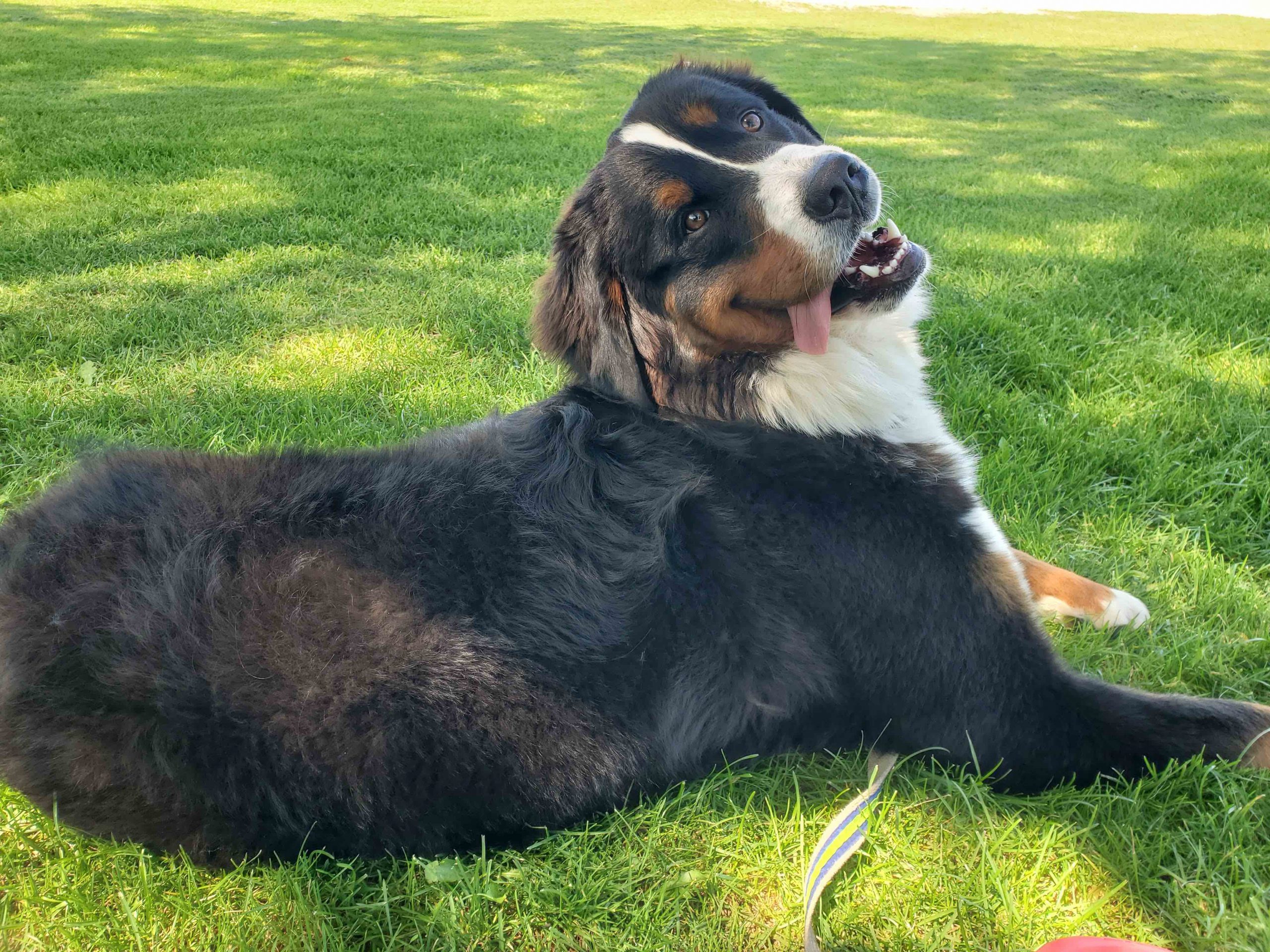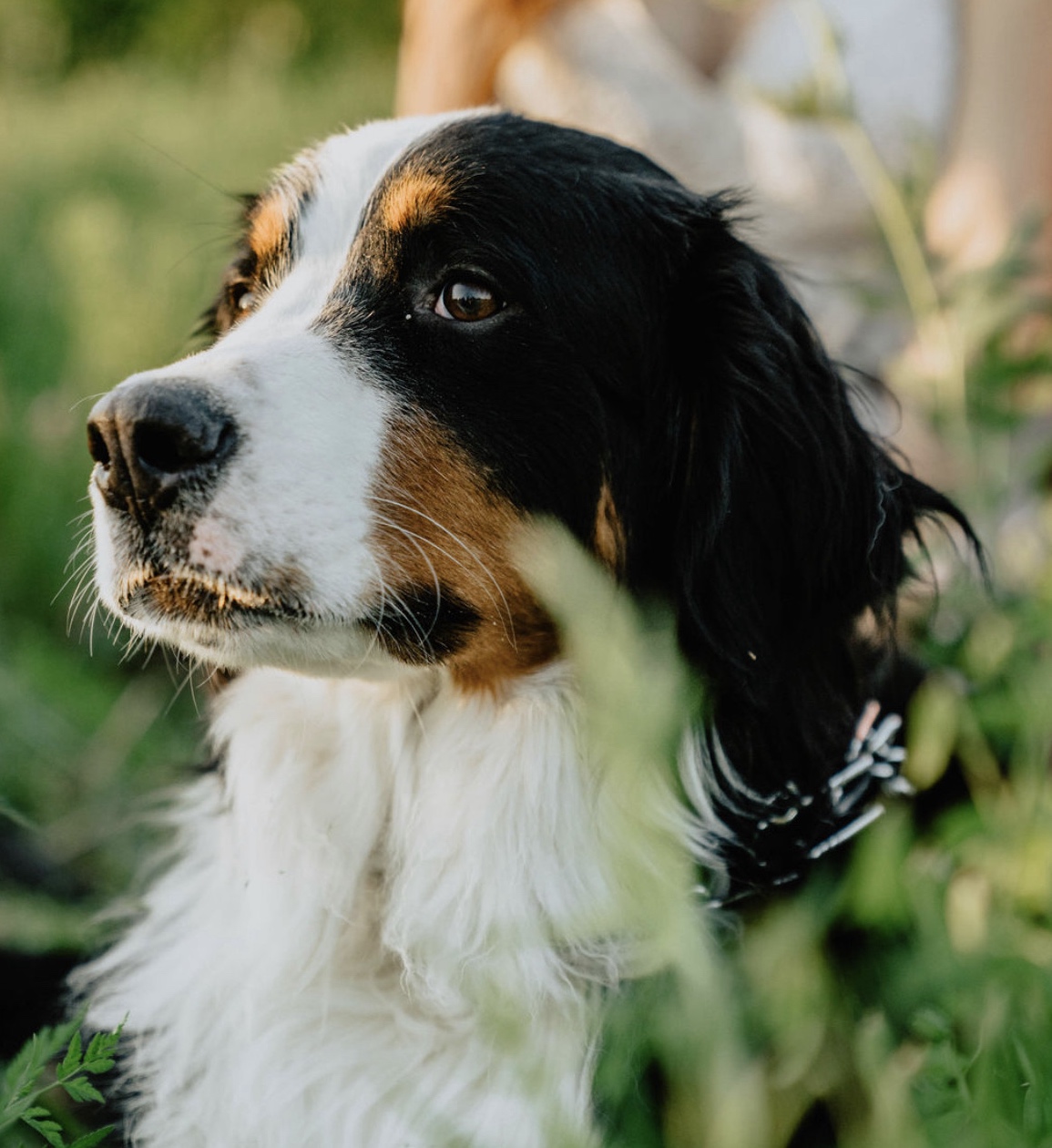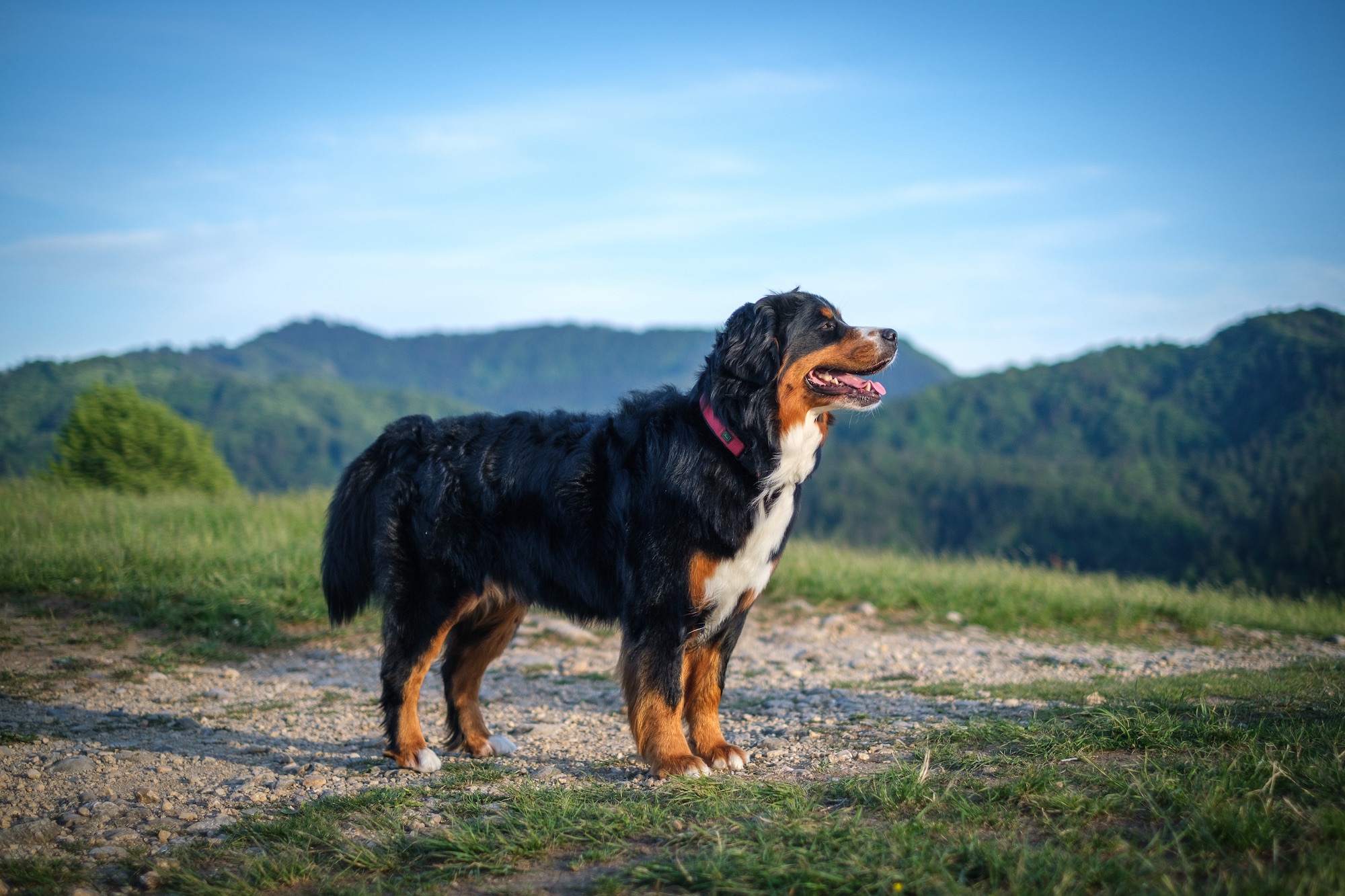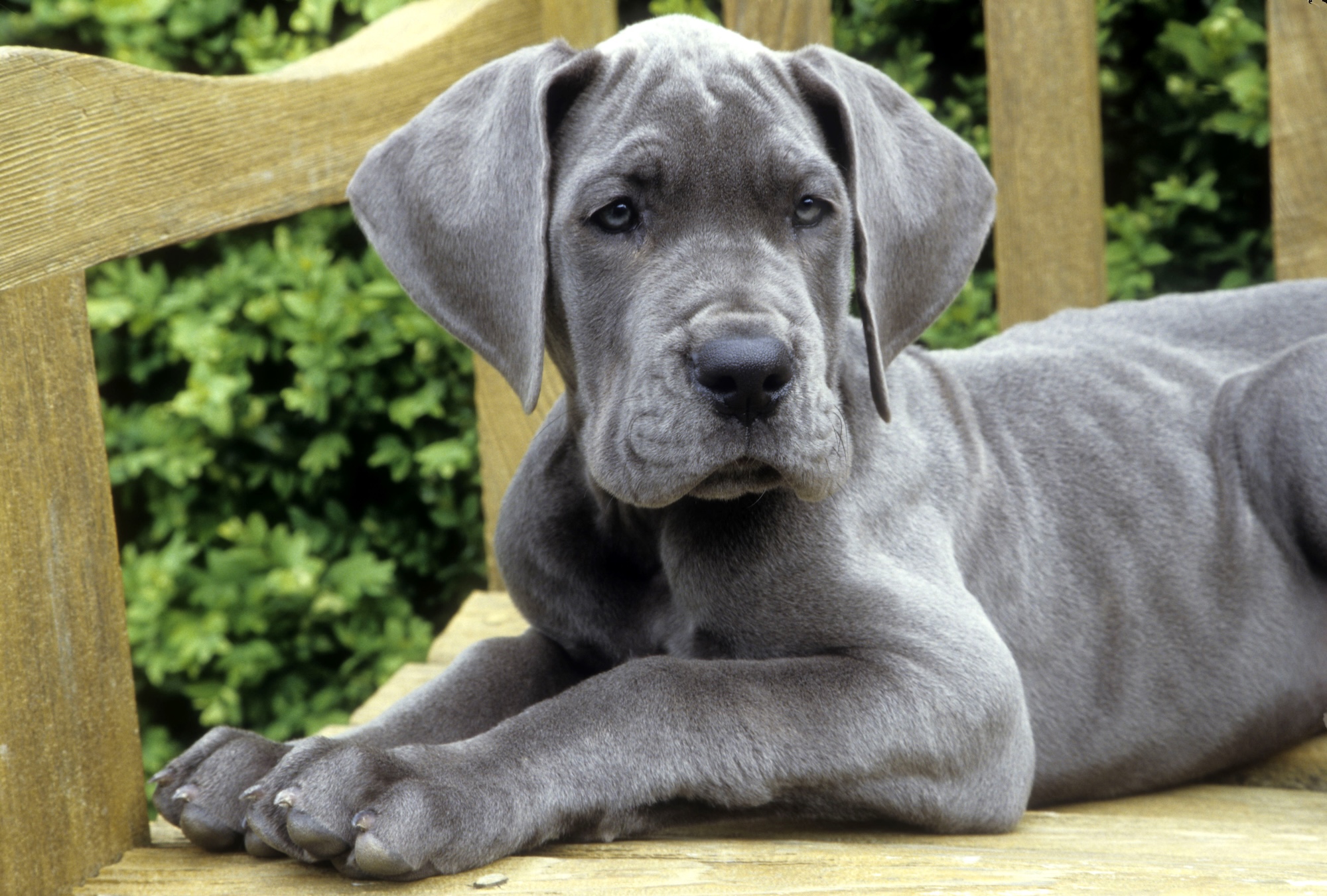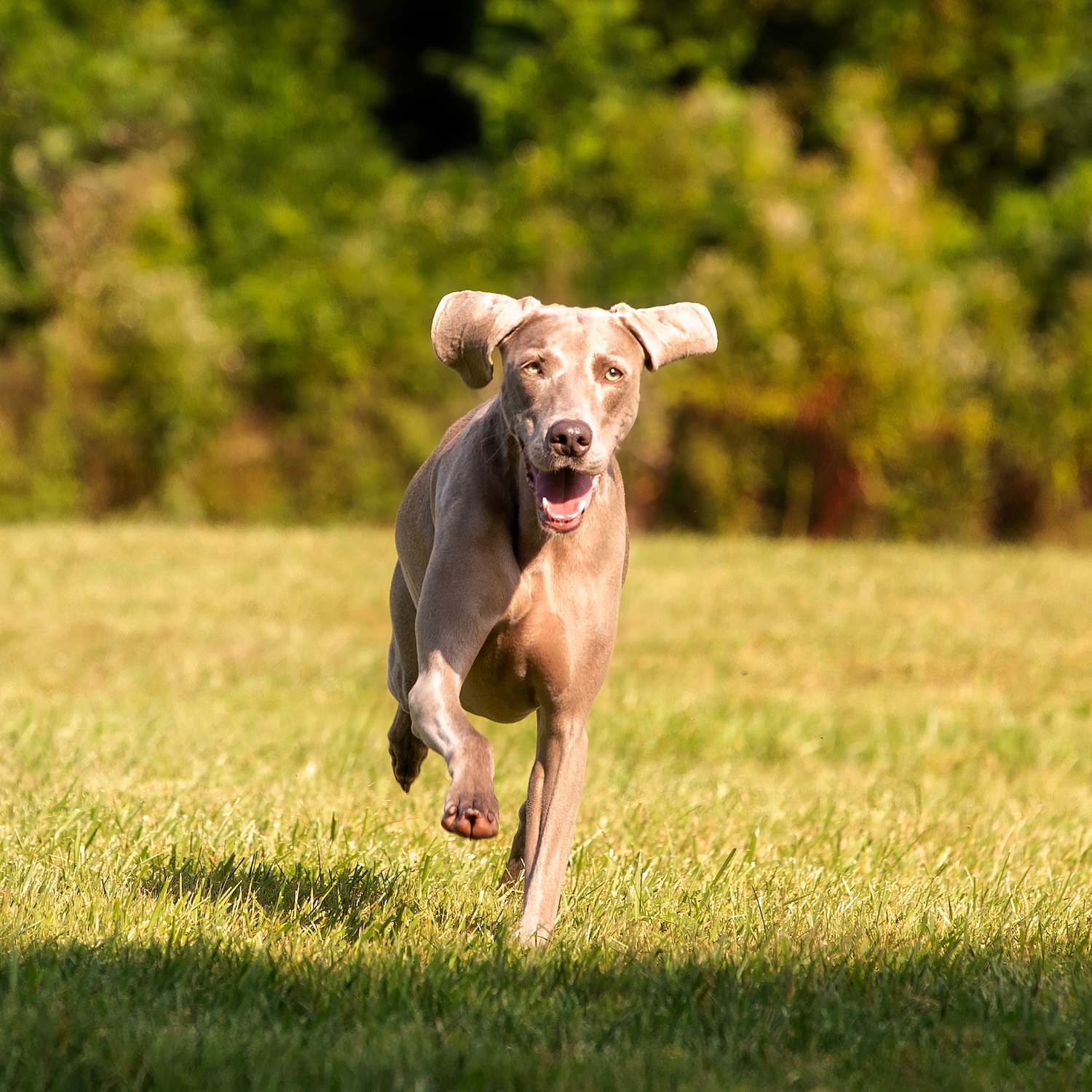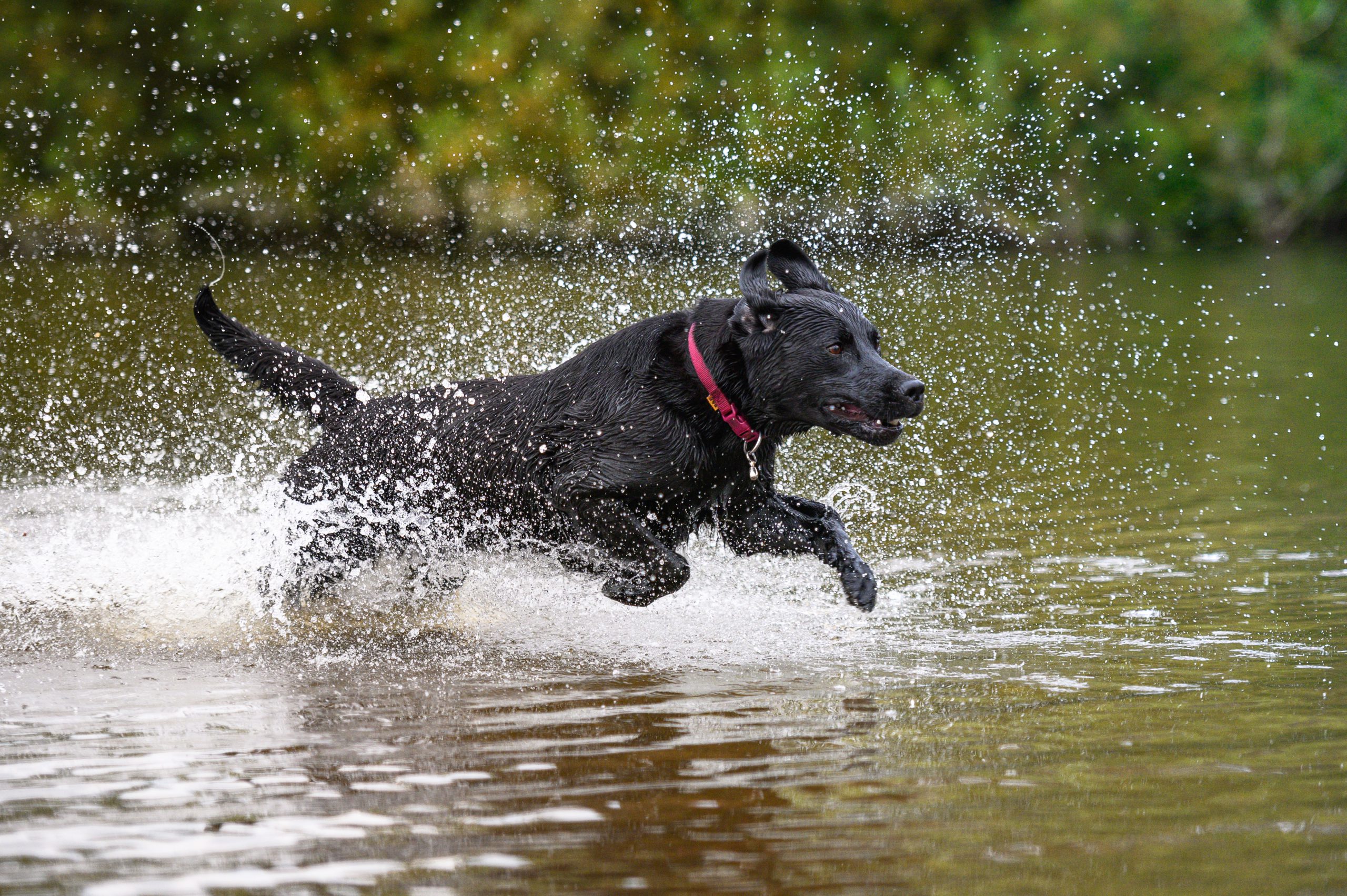The Bernese mountain dog originated in 19th-century Switzerland as a working breed on farms to guard, pull heavy loads, and drive livestock, and were introduced in the U.S. in the early 1900s. Today this breed makes a great family dog—one that enjoys being active, loves being outdoors, thrives in cold weather, and lives for getting lots of affection at home. These gentle giants are now one of the nation’s most popular breeds, and it’s easy to see why.
For anyone thinking about bringing home a Bernese mountain dog, or for existing owners wanting to better understand them, here’s the lowdown on these loyal, loving, good-natured dogs.
Basic Berner facts
With a long, thick, three-color coat and large frame (matched only by their big hearts), Berners are majestic-looking dogs. Males stand 25 to 27 inches at the shoulder, and weigh up to 115 pounds; females range from 23 to 26 inches, typically weighing up to 95 pounds.
“He doesn’t know his size,” says Berner owner Heather Fous of her dog, Moose. “He shares his love by lying right on top of you and giving kisses.”
The Berner coat is jet black with white and rust highlights on the face, legs, chest, and tail. In contrast to their imposing size, the Berner’s face is warm, friendly, and gentle.
A calm, sweet personality, and eager to please
All dogs are different, of course, but the typical Berner temperament is playful and easygoing. Berners are open to strangers and only moderately protective. “Moose is a major goofball and playful all around,” says Fous. “But he’s very patient and smart with other dogs, and likes to learn about others before he really goes all out and shares his quirky personality.” Although the breed is known for being sociable with other dogs and good with children, big, exuberant dogs are not always a good match for babies (or frail adults).
“Berners are very large dogs who consider themselves lapdogs and want to be involved in every aspect of your day,” says Kelly Stetter of the National Bernese Mountain Dog Rescue Network. “It’s the purest form of love.” She adds that Berners are “totally committed to their owners” and “love to be woven into the fabric of their family.”
“He’s sweet and stubborn,” Berner owner Sierra Rinaldi says affectionately of her dog, Bennie. “He can be extremely cuddly and loves to snuggle in the morning.” His attachment can prove a bit challenging: “Bennie follows me around and sits near my desk all day long,” she says. “This is so sweet, but I do worry about him being anxious when I need to leave the house for extended periods of time.” Socialization and training are essential to help prevent or alleviate separation anxiety, but Berners are probably not a good choice for households where they would be left alone for lengthy periods of time each day.
Like many dogs, Berners have their funny, lovable quirks. “Simon especially loves carrying a shoe in his mouth,” says Berner owner Tori Gwilt. “Anything from a flip-flop to a tennis shoe or a rain boot when he goes outside. It seems to give him comfort.” But, she adds, “He has never chewed or destroyed any shoes. He just enjoys carrying them around.”
Other owners describe a distinctive Berner “chuckle” in response to funny situations. Regardless of whether animals can understand humor, Berners do appear to enjoy human laughter. They’ll repeat an action that elicits laughs in the hope of generating more.
While the breed has a strong attachment to their people, sometimes they’re especially attached to one member of the family. “Truman is very sweet,” says Rafael Sharon of his family’s two-year-old Berner. “He gets along with everyone and all dogs. He’s very mellow—until my wife enters the room. He is so in love with Laura that he starts ‘talking’ and wagging his entire body every time she appears.”
Prill Trowbridge similarly reports the intense love her Berner, Cholla, shows toward her husband: “She has a habit of leaping into bed at 6 a.m., plopping all 100-plus pounds onto my husband’s head, and giving him a lengthy tongue bath while making grunting noises.” She adds: “Cholla loves literally everybody and all creatures.”
Berner history
The breed takes its name from the city and region of Bern, Switzerland, nestled on the high plateau north of the Alps, where invading Romans introduced its ancestors more than 2,000 years ago. Farmers used Berners to keep watch, pull carts, and serve as a family companion. As these were small farms with only a few cows, sheep, or goats, the dogs did not herd livestock, like their Appenzeller cousins, and living on a plateau meant Berners never carried brandy in a little barrel to stranded hikers, as did the Saint Bernard. The dogs did accompany cattle to pastures over short distances, but their main task was using their powerful bark to alert farmers to intruders.
Berners are categorized as Sennenhunds, a group of four working dogs with roots in Switzerland. The others are the Appenzeller, the Entlebucher, and the Greater Swiss mountain dog. A “senn” is a shepherd for cattle, “sennen” are alpine pastures, and “hund” means dog. In the late 1800s, interest grew in historic Swiss breeds, and a Swiss breeder named Albert Heim was determined to preserve the Berner, even as farms became larger and more mechanized. His efforts indirectly led to the introduction of two Bernese Mountain Dogs to the United States in 1936. A year later, the American Kennel Club recognized the breed as a member of its Working Group.
Famous friends
Despite their striking beauty and charisma, Berners have somehow ceded the canine spotlight in Hollywood to other big breeds. (Notably, a Saint Bernard stars in the “Beethoven” movies.)
Berners are in the public eye, however, thanks to several famous owners. Irish President Michael Higgins is a longtime Berner booster: in July 2018, newlyweds Prince Harry and Meghan Markle met the president’s Berners, Brod (which means “pride” in Gaelic) and Sioda on a visit to Ireland; the dogs liked them so much that they followed the couple on a tour of the president’s garden. Two years later, Catherine, Princess of Wales, and Prince William met Brod (Sioda was absent due to a paw injury). And in 2023, Higgins’s Berner, Misneach, whose name means “Courage,” made headlines after having barked at a visiting President Biden.
Actors Kurt Russell and Goldie Hawn posed for a 2018 Instagram post as Mr. and Mrs. Claus alongside their two Berners. Other celebrities who have owned Bernese Mountain Dogs include Selena Gomez, Courteney Cox, and Hilary Duff.
Training tips and exercise essentials
Berners are intelligent dogs who benefit from mental stimulation, training, and exercise. Socialization and obedience skills are essential to develop in any dog, but especially in large breeds such as Berners, who need to know their own strength and how to control it. These dogs respond well to training and enjoy learning; they’re also eager to please but also quick to get hurt feelings. Use positive reinforcement rather than sharp correction.
Berners need at least an hour of exercise a day. The breed’s outdoorsy heritage make it an ideal hiking or camping companion, too. Ideally, Berners will have access to a fenced yard for them to run around and chase balls—though active members of this big breed can be tough on your lawn.
Ambitious owners might want to bring their Berner to a local obstacle course designed to develop agility and confidence. And because these dogs used to pull carts loaded with dairy products, carting is another option. Team up with an experienced owner who has a cart, and at least one other dog to help pull.
For mental stimulation, consider looking into having your Berner serve as a therapy dog. The breed’s friendly and gentle demeanor make Berners great candidates for being out and about in their community. This service will require extra training, but again, Berners are intelligent and will enjoy the process.
Finally, a note about Berners and climate. The breed thrives in cold weather, even with snow, ice, and cold winds. They’re always up for going out. But hot weather? Not so much. “Summer and bright sun is tough for them,” Prill Trowbridge says. “I would not recommend owning this breed in the central or southern regions of the U.S.” On warm days, it’s a good idea to keep extended outdoor exercise to early mornings or late evenings. Make sure a bowl of clean, cool drinking water is accessible to your dog at all times.
Super shedders
With a Berner in the house, get ready for lots of fur… everywhere. And plenty of vacuuming. “Truman sheds. And sheds some more,” says Sharon of his two-year-old Berner, who has curly hair, unusual for the breed. Their distinctive coat is double layer, with a long outer layer over a wooly undercoat, and shed twice yearly—some owners would say daily.
“Moose sheds a lot, especially going into the summer, so I’m still learning what I need to do to stay on top of it,” says Fous. Females in heat also tend to shed a lot. Yet Berner coat maintenance is fairly straightforward: brush them at least weekly, daily as shedding season approaches, and bathe them periodically. Otherwise, the coat can get matted and trigger a range of skin and health problems, such as hot spots and fungal infections.
Common Berner health concerns
Bernese mountain dogs typically live from six to eight years. (Like other breeds such as Great Danes and Mastiffs, Berners have one of the shortest lifespans among all dog breeds.) Along with ailments common to all dogs, including cancer, arthritis, and dental disease, Berners are at risk for the following health concerns:
Histiocytic sarcoma: Berners are predisposed to several types of cancer, notably histiocytic sarcoma. Histiocytes are a type of immune cell, and when they proliferate excessively, they form lymphatic tumors in locations around the body. Scientists do not understand the root cause of histiocytic sarcoma, but consider it genetic. Where the disease surfaces determines both the symptoms and how to focus treatment. General symptoms include lethargy, loss of appetite, and depression. If the lungs are affected, coughing and difficulty breathing may arise; if the limbs are affected, movement may be difficult. Histiocytic sarcoma is diagnosed with a cytologic analysis or biopsy. Treatment options vary, depending on the area affected, but include tumor removal and chemotherapy. Early diagnosis of histiocytic sarcoma is critical, so alert your vet immediately to any notable changes in your dog’s behavior or appearance. And as always, ensure your dog gets plenty of exercise; healthy, fresh food; and regular visits to the vet.
Hip dysplasia: Common among large breeds, hip dysplasia is a serious condition that can cause pain, hinder a Berner’s mobility, and lead to arthritis. It occurs when the hip joint’s ball-and-socket connection doesn’t fit together smoothly; an X-ray can determine whether your dog has this condition, and what can be done to manage it. Talk with your vet right away if you observe that your Berner is suddenly struggling to walk or run. Although hip dysplasia is generally inherited, injury to the hip joint may also be a factor. Treatment options include prescription pain medication and nutritional supplements to support joint health, as well as alternative treatments such as acupuncture, laser, and hydrotherapy; and in some cases, hip-replacement surgery. Keeping your dog at a healthy weight can help keep joints healthy.
Hypothyroidism: When the thyroid gland doesn’t produce and release sufficient hormone, the result is hypothyroidism. Thyroid hormone regulates the body’s metabolism, which means that a Berner whose thyroid isn’t making enough may experience sluggishness, weight gain, hair loss, digestive issues, and other symptoms. Hypothyroidism is uncommon but serious, especially when undiagnosed, and may be the result of a thyroid tumor. A vet will check your dog for hypothyroidism by feeling the thyroid gland at the front of the neck, listening to the dog’s heart, and discussing any symptoms you may have noticed, but a blood test will provide the definitive answer. Although there is no cure for hypothyroidism, treatment options include hormone-replacement medicine, and surgery to remove the tumor (if possible). On a positive note, if treatment begins early, Berners with hypothyroidism can expect a good quality of life.
Von Willebrand Disease: Berners are more likely than most breeds to inherit this blood disease, which reduces the ability to clot. In many animals, including humans, a protein called the von Willebrand Factor helps blood clot; von Willebrand Disease occurs when this protein is absent or, in the case of Berners, reduced. Dogs with Type 1 vWD, the kind common to Berners, have a mild to moderate risk of bleeding. Common signs include easy bruising and bleeding from seemingly minor skin wounds. Also watch for bleeding gums, nose bleeds, and blood in urine or stool. A vet can diagnose vWD with a blood test. Treatments include clotting medication when undergoing medical procedures, and avoiding unnecessary surgery or drugs that may promote bleeding. As a genetic disease, it cannot be prevented or transmitted after birth.
Progressive retinal atrophy: This genetic eye disease strikes many breeds, including Bernese Mountain Dogs. Cells on the dog’s retina—the back of the interior eyeball that sense and transmit images—slowly degrade over time, eventually leading to blindness. The disease emerges in adulthood, affects both eyes, and is diagnosed by an eye exam. Signs to watch for include dilated pupils, abnormally reflective eyes, and hesitancy or clumsiness while walking, especially in low light. There’s no cure for PRA, but Berners tend to adapt to their gradually dimming eyesight. Help them manage the condition with supplemental lighting; not changing the arrangement of furniture in your home; limiting access to stairs, if necessary; and using a leash in unfamiliar areas.
Bloat: Also called gastric-dilation volvulus complex, bloat is a medical emergency. Bloat occurs when a dog’s stomach is filled with too much food, liquid, or gas, causing it to expand and put pressure on other organs. This can interfere with blood flow and breathing. It can also lead to gastric dilatation-volvulus (GDV), a potentially fatal condition in which excess gas causes the stomach to twist onto itself. More prevalent in large dogs, bloat must be treated quickly—so seek immediate medical attention if your Berner exhibits abdominal enlargement, belly pain, retching or excessive saliva. Treatment involves treating the shock, and surgery to correct the bloating and twisting. The exact causes of bloat are unclear, but preventive strategies include two or more smaller meals rather than one big one; using a slow-feeding bowl; and creating a low-stress feeding environment (for example, allowing anxious dogs to eat by themselves). Also, if your dog has been very active outside, such as romping around in the park, delay mealtime until your dog has settled down and rested a bit.
Allergies: Perhaps related to bloat, allergies can also be an issue for Berners. In general, an allergy is an immune reaction to a food or environmental trigger, or allergen. Food allergies can present as digestive issues like upset stomach and diarrhea, skin irritation, and even ear problems. To address these issues, consult your vet; they may suggest an elimination diet or other diagnostic or treatment paths. In addition to food allergies, Berners can be sensitive to dust, pollen, and insect bites. Managing dust at home can help, as does keeping your dog’s hair and skin clean. Your vet may also recommend medication or supplements, if needed.
Food and nutrition
Like all dogs, Bernese mountain dogs need digestible, complete, and balanced food—a diet that supplies enough energy for daily activities, while helping them maintain a healthy weight.
Watch their weight: One of the best things you can do to look out for the long-term health of your Berner (or any dog) is to keep them at a healthy weight and lean body condition. The major Berner health concerns, notably hip dysplasia and hypothyroidism, may also be positively influenced if the dog maintains a healthy weight. Extra weight puts additional stress on the joints, metabolism, and heart, so it’s important to control meal portions and calorie intake while ensuring proper nutrition. A fresh-food plan makes it easy to feed the right amount of food for your dog’s age, size, and activity level, making weight management more straightforward.
High-quality food for high-quality poops: A diet of fresh food has been shown to be more digestible than processed kibble. It can promote a healthy gut and improved digestion (which also means better, smaller poops).
Where to get a Berner
If a Bernese mountain dog sounds like the perfect dog for you, consider a local shelter or rescue organizations such as the National Bernese Mountain Dog Rescue Network, Heart of Michigan Bernese Mountain Dog Rescue, and Mountain Pet Rescue in Colorado.
